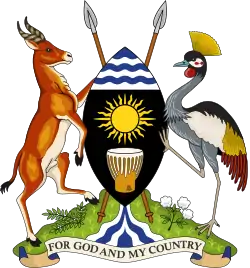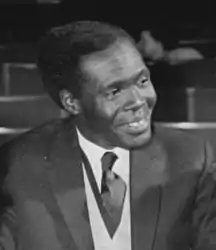List of heads of state of Uganda
This is a list of the heads of state of Uganda, from the independence of Uganda in 1962 to the present day.
 |
|---|
| This article is part of a series on the politics and government of Uganda |
|
|
From 1962 to 1963, the head of state under the Uganda Independence Act 1962 was the Queen of Uganda, Elizabeth II, who was also monarch of the other Commonwealth realms. The Queen was represented in Uganda by a Governor-General. Uganda became a republic under the Constitution of 1963, when the Monarch and Governor-General were replaced by a ceremonial President, which was replaced by an executive presidency in 1966.
Monarch (1962–1963)
The succession to the throne was the same as the succession to the British throne.
| No. | Portrait | Name (Birth–Death) |
Reign | Royal House | Prime minister(s) | ||
|---|---|---|---|---|---|---|---|
| Reign start | Reign end | Duration | |||||
| 1 | .jpg.webp) |
Queen Elizabeth II (1926–) |
9 October 1962 | 9 October 1963 | 1 year | Windsor | Obote |
Governor-General
The Governor-General was the representative of the Monarch in Uganda and exercised most of the powers of the Monarch. The Governor-General was appointed for an indefinite term, serving at the pleasure of the Monarch, and was appointed solely on the advice of the Cabinet of Uganda without the involvement of the British government. In the event of a vacancy, the Chief Justice served as Officer Administering the Government.
- Status
| No. | Portrait | Name (Birth–Death) |
Term of office | Monarch | Prime Minister(s) | ||
|---|---|---|---|---|---|---|---|
| Took office | Left office | Time in office | |||||
| 1 |  |
Walter Coutts (1912–1988) |
9 October 1962 | 9 October 1963 | 1 year | Elizabeth II | Obote |
First Republic (1963–1971)
Under the 1963 Constitution of the Republic of Uganda, the president replaced the monarch as ceremonial head of state. The president and vice-president were elected by the National Assembly for a 5-year term from among the traditional rulers and constitutional heads of districts.[1]
In 1966, the powers of the president were increased, with the establishment of the executive presidency, but the same rules applied concerning the vacancy of the president. It also applied to the 1967 and 1995 Constitutions.
Status
| No. | Portrait | Name (Birth–Death) |
Elected | Term of office | Political party | Prime minister(s) | ||
|---|---|---|---|---|---|---|---|---|
| Took office | Left office | Time in office | ||||||
| 1 |  |
Edward Mutesa (1924–1969) |
1963 | 9 October 1963 | 2 March 1966 (deposed.) |
2 years, 144 days | Kabaka Yekka | Obote |
| 2 |  |
Milton Obote (1925–2005) |
— | 2 March 1966 | 15 April 1966 | 44 days | Uganda People's Congress | Himself |
| 15 April 1966 | 25 January 1971 (deposed.) |
4 years, 285 days | Position abolished | |||||
Military rule (1971–1979)
General (later field marshal) Idi Amin led a 1971 coup d'état that overthrew President Obote and his government and installed Amin as president.
| No. | Portrait | Name (Birth–Death) |
Term of office | Military | Prime minister(s) | ||
|---|---|---|---|---|---|---|---|
| Took office | Left office | Time in office | |||||
| 3 | %252C_R23930288.jpg.webp) |
Idi Amin (1925–2003) |
25 January 1971 | 11 April 1979 (deposed.) |
8 years, 76 days | Ugandan Armed Forces | Position abolished |
Second Republic (1979–1985)
| No. | Portrait | Name (Birth–Death) |
Elected | Term of office | Political party | Prime minister(s) | ||
|---|---|---|---|---|---|---|---|---|
| Took office | Left office | Time in office | ||||||
| 4 |  |
Yusuf Lule (1912–1985) |
— | 13 April 1979 | 20 June 1979 (deposed.) |
68 days | Independent (UNLF) |
Position abolished |
| 5 |  |
Godfrey Binaisa (1920–2010) |
— | 20 June 1979 | 12 May 1980 (deposed.) |
327 days | Uganda People's Congress (UNLF) | |
| 6 |  |
Paulo Muwanga (1921–1991) |
— | 12 May 1980 | 22 May 1980 (resigned.) |
10 days | Uganda People's Congress (UNLF) | |
| — | Presidential Commission | — | 22 May 1980 | 15 December 1980 | 207 days | — | ||
| (2) |  |
Milton Obote (1925–2005) |
1980 | 17 December 1980 | 27 July 1985 (deposed.) |
4 years, 222 days | Uganda People's Congress | Allimadi |
Military rule (1985–1986)
General Bazilio Olara-Okello led a coup d'état that overthrew President Obote and his government. Following the coup, Okello proclaimed himself president.
| No. | Portrait | Name (Birth–Death) |
Term of office | Military | Prime minister(s) | ||
|---|---|---|---|---|---|---|---|
| Took office | Left office | Time in office | |||||
| 7 |  |
General Bazilio Olara-Okello (1929–1990) |
27 July 1985 | 29 July 1985 (resigned.) |
2 days | Ugandan Armed Forces | Position vacant |
| 8 |  |
General Tito Okello (1914–1996) |
29 July 1985 | 26 January 1986 (deposed.) |
181 days | Ugandan Armed Forces | Muwanga Waligo |
Third Republic (1986–present)
Under the constitution of Uganda, the president is the executive head of state. The president is elected by popular vote for a five-year term. In the event of a vacancy, the vice president served as acting president.
Status
| No. | Portrait | Name (Birth–Death) |
Elected | Term of office | Political party | Prime minister(s) | ||
|---|---|---|---|---|---|---|---|---|
| Took office | Left office | Time in office | ||||||
| 9 |  |
Yoweri Museveni (1944–) |
1996 2001 2006 2011 2016 2021 |
26 January 1986 | Incumbent | 35 years, 2 days | National Resistance Movement | Kisekka Adyebo Musoke Nsibambi Mbabazi Rugunda |
References
- Morris, H. F. (1966). "The Uganda Constitution, April 1966". Journal of African Law. 10 (2): 112–117. doi:10.1017/s0021855300004575. JSTOR 744686.